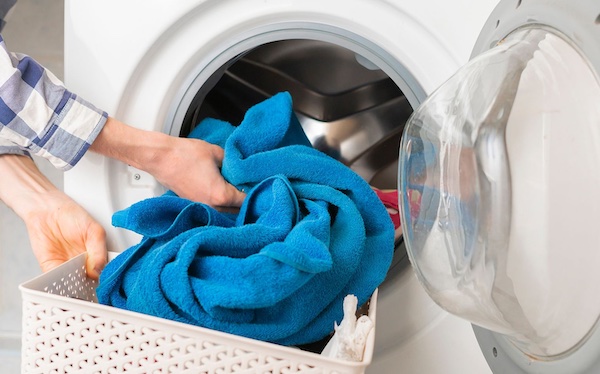After several uses, your towel won’t definitely be as it once was. You will notice that it no longer has its original softness regardless of how many times you wash them clean.
Vinegar is always the next option when it comes to washing towels. Washing your towels with vinegar and water can bring back their original softness. Washing your towel with vinegar in a front load washer is a super easy process.

How To Wash Towels with Vinegar in Front Loader
To wash your towels in a front load washer using vinegar:
- Start by adding the vinegar directly to the drum before you start the wash.
- If you want to use vinegar with your regular washing powder, you will have to add it to the fabric softener compartment so that it gets added automatically to the rinse cycle
- Add your towels to the washing drum. Ensure you only add similar colors together. Avoid overloading the drum. The towels will need all the room they can get to agitate freely to ensure maximum efficiency.
- Set a hot washing cycle to start the process.
- You can also go for a second wash, this time with half a cup of baking soda on a hot cycle. This should neutralize must or sour odors in your towels.
How to Use a Front Loader
Using a front-load washer requires a learning curve. Once you know it works and how to use it correctly, you won’t have problems washing your clothes with the machine. Below, we’ve broken down the steps to learning how to use the front load washer.
Water Usage
One of the advantages of a front load washer is that it is energy efficient. The front load washer uses less water (about 13 gallons) less than a standard top load washer. The washer is also able to spin clothes at a rapid rate to extract more water and reduce the time in the dryer.
When you add clothes into a front load washer, the machine will add a small amount of water usually below the level of the door, and begin the cycle. As the water is absorbed by the clothes, more water will be sprayed to maintain the water level. Some front load washers allow you to select the water level and load size to ensure adequate water is used for your load.
Detergent Usage
Since front load washers make use of less water, it requires much less detergent to work with. The important thing is to go for a detergent that is formulated for high-efficiency machines. You will notice these detergents are labeled with the HE logo and are formulated to produce very little soap.
Going for these detergents is important as they don’t produce lots of bubbles or foam. With so many bubbles, your front load washer’s lifespan is reduced significantly. The bubbles will overflow the washer which could cause damage to the electronic system and void your warranty. In addition, the use of less water means the extra detergent will be left in your clothes.
Depending on your washer, you might not have to add the detergent yourself. Some washers have dispenser drawers that will slowly release the correct amount of detergent from the reservoir for each load. However, if you’re adding the detergent yourself, use no more than one tablespoon of HE detergent. If the product is 2x concentrate, then use two teaspoons. for 3x concentrate, use one teaspoon.
Loading the Washer
How you load the front load washer can determine its efficiency in cleaning your clothes. A front load washer should be loaded by the amount of space the dirty laundry takes up in the drum. Avoid overfilling the drum as it can result in clothes that are not cleaned correctly.
Be sure to add a proper mix of large and small items in each load to ensure balance. A load of only small items will not tumble correctly and can cause imbalance. Unbalance loads can be problematic for the washer and could cause quick wear and tear on the machine.
Before getting clothes into the washer, check the pockets, close the zippers, fasten any hooks, and follow every other rules in the user manual
Preventing Washer Odor
The front load washer is notoriously for its odor. Many users have complained of a musty odor after a few months of use. Proper maintenance is the only way to keep a front load odor-free. Cleaning your front load washer will prevent any transfer of odors from your laundry to the washing machine.
How to Clean and Maintain Your Front Load Washer
Cleaning and maintaining your front load washer is the easiest way to prevent odors and maintain its lifespan. The cleaning tips below need to be performed monthly or as often as you wash heavily soiled clothes. If you live in a hot, humid area, then you should clean it more often.
Cleaning the Washer Door and Drum
Use a soft, absorbent cloth to dry around the washer door and drum. You should wipe these down with a dry cloth after every load to ensure a watertight seal.
Ensure you properly clean the inside of the door gaskets and the edges. After washing oil-soaked items, you might notice a dirty residue on the drum, repeating the entire cleaning cycle using chlorine bleach should help clear this up.
Cleaning the Dispenser Drawers
With continuous use, detergent and fabric softener may build up in the dispenser drawers which could cause odors and operational problems. You should clean and remove the residue once or twice a month. To remove the drawers for cleaning, check your washer user’s manual.
Rinse the drawer with hot tap water to remove traces of accumulated powders and liquids. Also, use a small soft brush to clean the drawer opening on the washer. Once the drawer is clean, replace the dispenser drawer and run a short cycle without any laundry in the drum to completely flush the system.
Clean the Exterior of the Washer
Cleaning the outside of the washer is also important. Wipe the top and sides of the washing machine after every laundry session. All that is needed is for you to wipe with a damp cloth. Also, clean the exterior surfaces with warm water mixed with a mild soap. Avoid using hard or abrasive cleaners on enameled surfaces.




